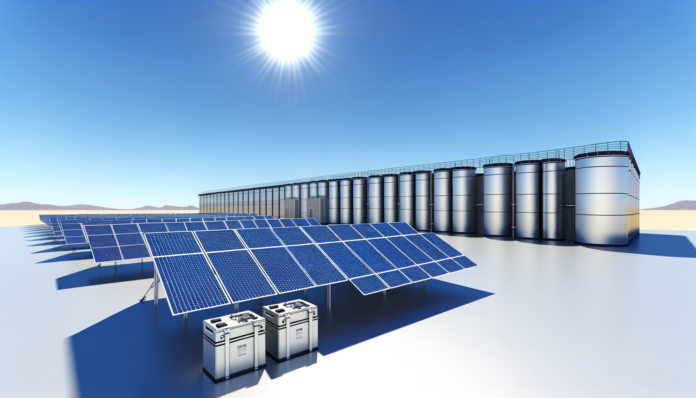Introduction to Solar Energy Storage
The Importance of Solar Energy
Solar energy has emerged as a cornerstone of the global transition to renewable energy sources. As a clean, abundant, and sustainable resource, solar power offers a viable solution to the pressing challenges of climate change and energy security. By harnessing the sun’s energy, we can significantly reduce our reliance on fossil fuels, thereby decreasing greenhouse gas emissions and mitigating environmental degradation. The adoption of solar energy is not only crucial for environmental sustainability but also for economic growth, as it creates jobs and stimulates technological innovation.
Challenges in Solar Energy Storage
Despite its numerous advantages, solar energy faces a significant hurdle: intermittency. Solar power generation is inherently dependent on weather conditions and the time of day. When the sun is not shining, such as during nighttime or cloudy days, solar panels cannot produce electricity. This intermittency poses a challenge for maintaining a consistent and reliable energy supply. Energy storage systems (ESS) are essential to address this issue, as they can store excess energy generated during peak sunlight hours and release it when production is low or demand is high. However, current storage technologies face limitations in terms of capacity, efficiency, and cost, making it imperative to develop more advanced solutions.
The Need for Breakthroughs
The growing adoption of solar energy underscores the urgent need for breakthroughs in energy storage technologies. As the share of solar power in the global energy mix increases, so does the demand for efficient and scalable storage solutions. Innovations in this field are crucial for enhancing the reliability and stability of solar energy systems. Recent advancements in battery technology, thermal storage, and mechanical storage solutions hold promise for overcoming existing limitations. By investing in research and development, we can unlock new possibilities for energy storage, ensuring a sustainable and resilient energy future.
In summary, while solar energy offers immense potential for a cleaner and more sustainable world, its success hinges on the development of effective energy storage systems. Addressing the challenges of intermittency and advancing storage technologies are critical steps toward realizing the full potential of solar power.
Current Technologies in Solar Energy Storage
Batteries: Types and Uses
Batteries are the most common form of solar energy storage, and they come in various types, each with its own set of advantages and applications. **Lithium-ion batteries** are the most widely used due to their high energy density, long lifespan, and efficiency. They are ideal for residential and commercial solar energy systems, providing reliable storage and quick discharge capabilities. **Lead-acid batteries**, although older technology, are still in use for off-grid solar systems due to their lower cost. However, they have a shorter lifespan and lower efficiency compared to lithium-ion batteries.
**Flow batteries** represent a newer technology that stores energy in liquid electrolytes. These batteries are scalable and have a longer lifespan, making them suitable for large-scale applications such as utility-scale solar farms. **Graphene-based batteries** are another emerging technology, known for their superior energy density and rapid charging capabilities, which can significantly enhance the efficiency of solar energy systems.
Thermal Storage Systems
Thermal storage systems capture and store solar energy in the form of heat, which can be used later to generate electricity or provide heating. One common method is the use of **molten salt** as a storage medium. Molten salt can retain heat for extended periods, allowing for the generation of electricity even when the sun is not shining. This technology is particularly useful in concentrated solar power (CSP) plants, where mirrors focus sunlight to heat the salt.
Another innovative approach is **phase change materials (PCMs)**, which absorb and release thermal energy during the process of melting and solidifying. PCMs can be integrated into building materials to provide passive heating and cooling, enhancing energy efficiency in residential and commercial buildings.
Mechanical Storage Solutions
Mechanical storage solutions convert and store solar energy in mechanical forms, which can be converted back into electricity when needed. **Pumped hydro storage** is the most established form of mechanical storage. It involves pumping water to a higher elevation during periods of excess solar energy production and releasing it to generate electricity when demand is high.
**Flywheel energy storage** is another mechanical solution that stores energy by accelerating a rotor to a high speed and maintaining the energy in the form of rotational energy. When electricity is needed, the flywheel’s rotational energy is converted back into electrical energy. Flywheels offer high efficiency and rapid response times, making them suitable for stabilizing grid fluctuations.
**Compressed air energy storage (CAES)** involves compressing air and storing it in underground caverns or tanks. When electricity is needed, the compressed air is released and expanded to drive turbines that generate electricity. CAES systems can store large amounts of energy and are particularly useful for balancing supply and demand in large-scale solar installations.
In summary, the current technologies in solar energy storage—ranging from advanced batteries and thermal systems to mechanical solutions—are crucial for enhancing the reliability and efficiency of solar power. These technologies address the intermittent nature of solar energy, ensuring a stable and continuous supply of electricity.
Recent Breakthroughs in Solar Energy Storage
Advancements in Battery Technology
The landscape of solar energy storage has been significantly transformed by recent advancements in battery technology. **Lithium-ion batteries**, which have long been the industry standard, are now more efficient, durable, and cost-effective than ever before. Innovations in battery chemistry and design have led to higher energy densities and longer lifespans, making them ideal for both residential and commercial solar energy storage solutions.
Moreover, **solid-state batteries** are emerging as a promising alternative. These batteries replace the liquid or gel electrolyte found in traditional lithium-ion batteries with a solid electrolyte, which enhances safety and energy density. This technology is still in the developmental stage but holds the potential to revolutionize solar energy storage by offering higher efficiency and reduced risk of overheating or fire.
Another exciting development is the rise of **flow batteries**, particularly vanadium redox flow batteries. These batteries store energy in liquid electrolytes contained in external tanks, allowing for scalable storage capacity. Flow batteries are particularly well-suited for large-scale solar farms and grid applications due to their long cycle life and ability to discharge energy over extended periods.
Innovations in Thermal Storage
Thermal storage systems have also seen significant innovations, providing an efficient way to store solar energy in the form of heat. **Molten salt storage** is one such technology that has gained traction. In this system, solar energy is used to heat a mixture of sodium and potassium nitrate salts to high temperatures. The stored thermal energy can then be converted back into electricity when needed, offering a reliable and efficient storage solution.
Another noteworthy innovation is the development of **phase change materials (PCMs)**. These materials absorb and release thermal energy during the process of melting and solidifying. PCMs can store large amounts of energy in a relatively small volume, making them ideal for residential and commercial applications. Recent advancements have focused on improving the thermal conductivity and stability of these materials, enhancing their efficiency and lifespan.
Additionally, **thermochemical storage** is an emerging technology that stores energy through reversible chemical reactions. This method offers high energy density and long-term storage capabilities, making it a promising solution for integrating solar energy into the grid.
Emerging Mechanical Storage Techniques
Mechanical storage solutions are also making strides, offering innovative ways to store and release solar energy. **Pumped hydro storage** remains one of the most established methods, where water is pumped to a higher elevation using excess solar energy and then released to generate electricity when needed. Recent advancements have focused on improving the efficiency and environmental impact of these systems.
**Compressed air energy storage (CAES)** is another mechanical storage technique gaining attention. In CAES systems, excess solar energy is used to compress air, which is then stored in underground caverns or tanks. When electricity is needed, the compressed air is released to drive a turbine and generate power. Innovations in this field are aimed at enhancing the efficiency and scalability of CAES systems.
Lastly, **flywheel energy storage** is an emerging technology that stores energy in the form of rotational kinetic energy. Flywheels can rapidly absorb and release energy, making them suitable for applications requiring quick response times. Recent developments have focused on improving the materials and design of flywheels to increase their energy storage capacity and reduce friction losses.
In summary, the recent breakthroughs in battery technology, thermal storage, and mechanical storage techniques are paving the way for more efficient and reliable solar energy storage solutions. These innovations are crucial for overcoming the intermittency of solar power and ensuring a stable and sustainable energy supply for the future.
Case Studies: Successful Implementations
Off-Grid Living Solutions
Off-grid living has become increasingly popular as individuals and communities seek to reduce their reliance on traditional power grids and embrace sustainable living. Solar energy storage systems play a crucial role in making off-grid living viable by ensuring a consistent power supply even when the sun isn’t shining.
One notable example is the implementation of solar energy storage in remote cabins and tiny homes. These dwellings often use a combination of solar panels and battery storage systems to provide electricity for lighting, heating, and appliances. Lithium-ion batteries are commonly used due to their high energy density and long lifespan. For instance, the Tesla Powerwall has been a game-changer for many off-grid enthusiasts, offering reliable energy storage that can power a home through the night and during cloudy days.
In addition to individual homes, entire off-grid communities have successfully adopted solar energy storage solutions. The Earthship community in Taos, New Mexico, is a prime example. This community of sustainable homes relies on solar panels and battery storage to meet all their energy needs, demonstrating the feasibility of off-grid living on a larger scale.
Outdoor and Adventure Applications
Solar energy storage systems have also found a niche in outdoor and adventure applications, providing power in remote locations where traditional energy sources are unavailable. These applications range from camping and hiking to scientific expeditions and disaster relief efforts.
Portable solar chargers and battery packs are popular among outdoor enthusiasts. Products like the Goal Zero Yeti series offer compact, portable power stations that can be charged via solar panels. These devices provide a reliable source of energy for charging phones, cameras, and other essential gear, making them indispensable for extended trips into the wilderness.
In more extreme environments, such as polar expeditions or remote scientific research stations, robust solar energy storage systems are essential. The Princess Elisabeth Antarctica research station, for example, uses a combination of solar panels and advanced battery storage to operate entirely off-grid in one of the harshest climates on Earth. This setup not only powers the station’s scientific equipment but also provides heating and lighting, showcasing the versatility and reliability of solar energy storage in extreme conditions.
Emergency and Backup Power Systems
Solar energy storage systems are increasingly being used for emergency and backup power, providing a reliable source of electricity during power outages and natural disasters. These systems are particularly valuable in areas prone to hurricanes, earthquakes, and other events that can disrupt the power grid.
One successful implementation is the use of solar energy storage in hospitals and emergency shelters. During Hurricane Maria in 2017, Puerto Rico’s power grid was severely damaged, leaving many without electricity for months. In response, several hospitals and shelters installed solar panels and battery storage systems to ensure they could continue to operate during future outages. These systems have since provided critical power during subsequent storms, highlighting the importance of solar energy storage in disaster resilience.
Residential backup power systems are also becoming more common. Homeowners are increasingly installing solar panels paired with battery storage to ensure they have power during grid outages. The Enphase Energy IQ8 series, for example, offers grid-agnostic capabilities, allowing homes to maintain power even when the grid is down. This not only provides peace of mind but also enhances energy independence and resilience.
In conclusion, these case studies illustrate the diverse and impactful applications of solar energy storage systems. From off-grid living and outdoor adventures to emergency and backup power, these systems are proving to be essential in providing reliable, sustainable energy across a wide range of scenarios. As technology continues to advance, the potential for solar energy storage to transform our energy landscape will only grow.
Environmental and Economic Impact
Reducing Carbon Footprint
The integration of advanced solar energy storage systems plays a pivotal role in reducing our carbon footprint. By enabling the efficient storage of solar energy, these systems minimize the reliance on fossil fuels, which are major contributors to greenhouse gas emissions. **Solar energy storage** allows for the capture and use of solar power even when the sun isn’t shining, ensuring a continuous supply of clean energy. This capability is crucial for achieving deep decarbonization of electricity systems, as it balances the intermittency of solar power and reduces the need for carbon-intensive peaker plants. The widespread adoption of solar storage technologies can significantly cut down on emissions, contributing to global efforts to combat climate change.
Cost-Effectiveness of Solar Storage
One of the most compelling economic benefits of solar energy storage is its cost-effectiveness. While the initial investment in solar storage systems can be substantial, the long-term savings are considerable. **Lithium-ion batteries**, for instance, have seen a dramatic decrease in costs over the past decade, making them more accessible for both residential and commercial applications. Additionally, the ability to store excess solar energy and use it during peak demand periods reduces the need for expensive grid electricity, leading to lower utility bills. Innovations in battery technology, such as **solid-state batteries** and **flow batteries**, promise even greater efficiency and cost savings. Moreover, the integration of **Artificial Intelligence (AI)** in managing these systems optimizes energy usage, further enhancing their economic viability.
Long-Term Sustainability
The long-term sustainability of solar energy storage systems is another critical factor driving their adoption. Unlike fossil fuels, which are finite and environmentally damaging, solar energy is abundant and renewable. By investing in solar storage technologies, we are not only ensuring a sustainable energy supply but also promoting energy independence. **Flow batteries**, for example, offer scalable and long-lasting energy storage solutions that are ideal for large-scale applications. These systems can be co-optimized with other renewable energy sources and grid infrastructure to create a resilient and sustainable energy ecosystem. Furthermore, the environmental benefits of reduced emissions and the economic advantages of lower energy costs contribute to a more sustainable and prosperous future.
In summary, the environmental and economic impacts of solar energy storage systems are profound. They offer a viable solution for reducing carbon emissions, provide cost-effective energy storage options, and ensure long-term sustainability. As technology continues to advance, the benefits of solar energy storage will only become more pronounced, paving the way for a cleaner, more efficient, and sustainable energy future.
Future Trends in Solar Energy Storage
Predicted Technological Advancements
The future of solar energy storage is brimming with potential, driven by continuous technological advancements. One of the most promising areas is the development of next-generation batteries. **Solid-state batteries**, for instance, are expected to replace traditional lithium-ion batteries due to their higher energy density, longer lifespan, and enhanced safety features. Additionally, **flow batteries** are gaining traction for large-scale energy storage applications, offering the ability to store energy for extended periods without significant degradation.
Another exciting development is the integration of **artificial intelligence (AI)** and machine learning algorithms into energy storage systems. These technologies can optimize energy usage, predict maintenance needs, and enhance the overall efficiency of solar energy systems. AI-driven energy management systems can dynamically adjust storage and distribution based on real-time data, ensuring maximum efficiency and reliability.
Moreover, advancements in **thermal energy storage** are set to revolutionize the industry. Innovations such as phase-change materials and molten salt storage systems can store excess solar energy as heat, which can later be converted back into electricity. These systems are particularly beneficial for concentrated solar power (CSP) plants, providing a reliable and efficient way to store and dispatch solar energy.
Potential Market Growth
The market for solar energy storage is poised for significant growth in the coming years. According to industry forecasts, the global energy storage market is expected to grow at a compound annual growth rate (CAGR) of over 20% through 2030. This growth is driven by several factors, including declining costs of storage technologies, increasing demand for renewable energy, and supportive government policies.
**Residential energy storage systems** are becoming more popular as homeowners seek to maximize their solar investments and achieve energy independence. The rise of electric vehicles (EVs) is also contributing to market growth, as EV batteries can double as home energy storage units, providing additional flexibility and resilience.
On a larger scale, **utility-scale storage projects** are being developed to support grid stability and integrate higher levels of renewable energy. These projects are essential for managing the intermittent nature of solar power and ensuring a reliable energy supply. Governments and utilities are investing heavily in these projects, recognizing their critical role in the transition to a sustainable energy future.
Integration with Smart Grids
The integration of solar energy storage with smart grids represents a transformative trend in the energy sector. Smart grids use digital technology to monitor and manage the flow of electricity, enabling more efficient and reliable energy distribution. When combined with advanced energy storage systems, smart grids can significantly enhance the performance and resilience of the power grid.
One of the key benefits of this integration is the ability to perform **demand response**. Energy storage systems can store excess solar energy during periods of low demand and release it during peak demand, reducing the need for fossil fuel-based peaking power plants. This not only lowers greenhouse gas emissions but also reduces energy costs for consumers.
Furthermore, smart grids facilitate **peer-to-peer energy trading**, allowing individuals and businesses to buy and sell excess solar energy directly. This decentralized approach empowers consumers, promotes energy independence, and fosters the growth of local energy markets.
In conclusion, the future of solar energy storage is bright, with technological advancements, market growth, and smart grid integration driving the industry forward. These trends will play a crucial role in overcoming the challenges of solar energy storage, ensuring a sustainable and reliable energy future.
Conclusion
Summary of Key Points
The journey through the landscape of solar energy storage has highlighted several critical aspects. **Solar energy** is a clean, sustainable, and abundant resource, but its intermittency poses significant challenges. To address this, various **solar energy storage technologies** have been developed, including batteries, thermal storage systems, and mechanical storage solutions. Recent breakthroughs in these areas, such as advancements in battery technology and innovations in thermal and mechanical storage, are making solar energy more practical and cost-effective. Case studies have demonstrated successful implementations in off-grid living, outdoor applications, and emergency power systems, showcasing the versatility and reliability of modern solar storage solutions. Furthermore, the environmental and economic impacts of these technologies are profound, offering reductions in carbon footprints, cost-effectiveness, and long-term sustainability.
The Path Forward
As we look to the future, the path forward for solar energy storage is paved with **technological advancements** and **market growth**. Predicted advancements include more efficient and durable storage solutions, integration with smart grids, and the development of new materials and technologies that enhance storage capacity and efficiency. The market for solar energy storage is expected to grow significantly, driven by increasing demand for renewable energy and supportive policies. Integration with smart grids will further enhance the reliability and efficiency of solar energy systems, enabling better management of energy production and consumption. The continued focus on research and development, coupled with supportive regulatory frameworks, will be crucial in driving these advancements and ensuring that solar energy storage becomes an integral part of our energy infrastructure.
Call to Action for Sustainability
The advancements in solar energy storage present a unique opportunity to **transform our energy systems** and move towards a more sustainable future. However, realizing this potential requires concerted efforts from all stakeholders, including governments, businesses, and individuals. **Governments** must implement policies that support the development and adoption of solar energy storage technologies, including incentives for research and development, subsidies for installation, and regulations that promote renewable energy. **Businesses** should invest in solar energy storage solutions, not only to reduce their carbon footprint but also to gain a competitive edge in a rapidly evolving energy market. **Individuals** can contribute by adopting solar energy solutions in their homes and advocating for sustainable energy policies. Together, we can harness the power of solar energy and storage technologies to create a cleaner, more sustainable, and resilient energy future.
In conclusion, the breakthroughs in solar energy storage systems are not just technological achievements; they are stepping stones towards a sustainable future. By embracing these advancements and working collectively, we can ensure that solar energy plays a pivotal role in meeting our energy needs and protecting our planet for future generations.






